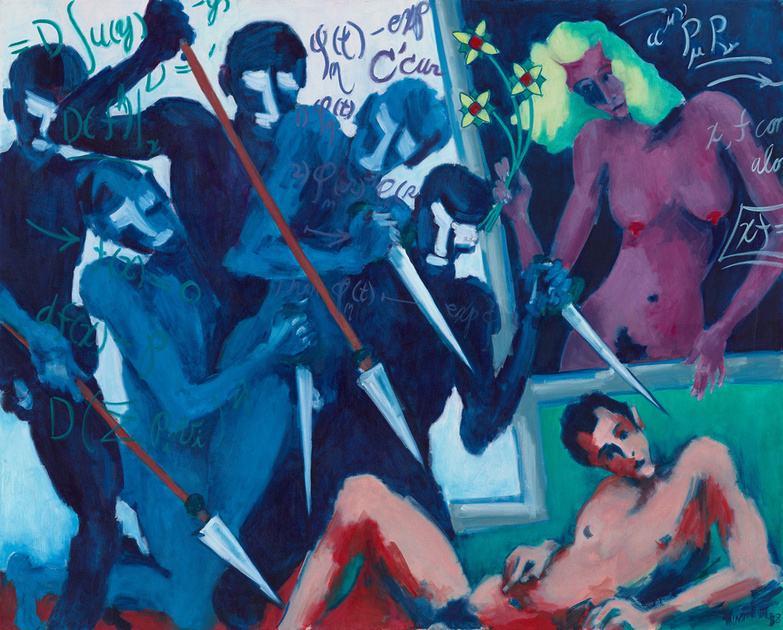The Path Less Travelled
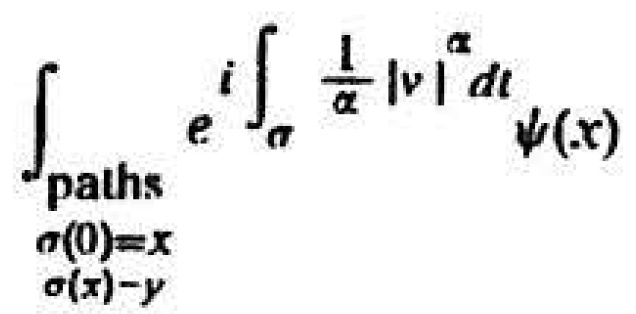

Will's day-job rarely became the subject of his painting, at least not overtly. None of his watercolors and only 4/200 of his oil paintings depicted mathematics. All of these were done in 1988. I remember at that time, Will was particularly animated about Feynman path integration. He was excited that these ideas, developed for quantum mechanics, might be generalized to a much broader class of problem. The earliest publication of Will's I could find was done with his colleague, Andrew Winkler, and released as an IBM research report.
Why this mathematical topic and not others for painting? I remember Will being equally excited about "the locomotive operator", and various incarnations of neural nets. When my own chosen course of study turned to biophysics, I was bombarded by Will with questions to do with real neurons. Real biology texts were incomprehensible to him, but I knew how to translate the biology into mathematics. A skill I had to learn, and that I continue to put to good use.
Three of the paintings have a common theme that includes two adjacent chalk boards. One white, one black, left to right. Duality in quantum mechanics? This sharp contrast is mirrored in the face of the muse, and the faces of these spear wielding primitive hunters.
It is tempting to look at "Math Demons" and imagine it to be a simple representation of being tormented. That would be too simplistic for Will. There are no shortage of depictions of torment in his other paintings, none of which use primitive hunters. Since their coloration mimics that of the black boards, I suspect they refer instead to the use of the word "primitive" in some operational sense. I.e. the opposite of sophisticated, simple, trivial or axiomatic. Moreover, I do not recall him being tormented by his work. Quite the opposite. I remember him bitterly complaining about IBM inhibiting his progress and that might well have been around this time. Of course, IBM is also known as big blue. (Okay, this last one is a stretch).
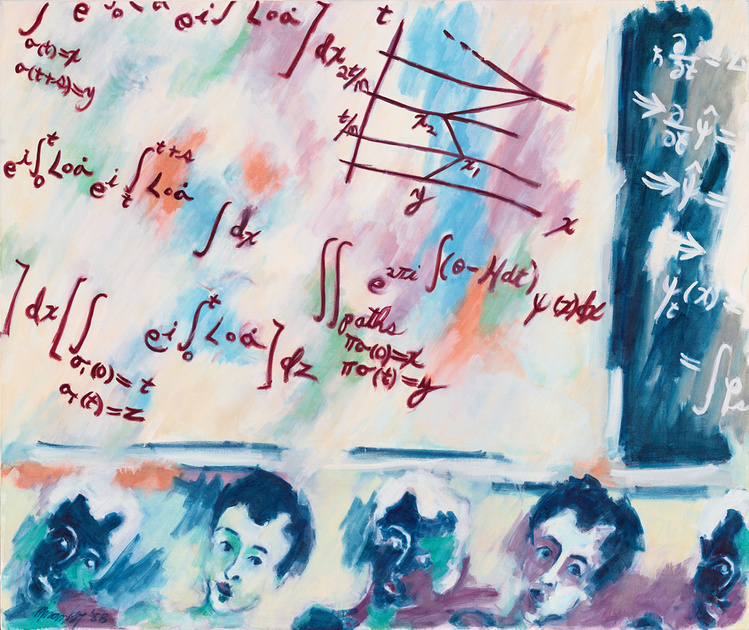 Equations (Janine) with Line of Heads1988, 50 x 60
Equations (Janine) with Line of Heads1988, 50 x 60
Here too, the faces alternate black and white. Are these self-portraits? I think the resemblance is weak. I recall he used a mirror and his own face for guidance when drawing even when he had no intention of drawing his own likeness.
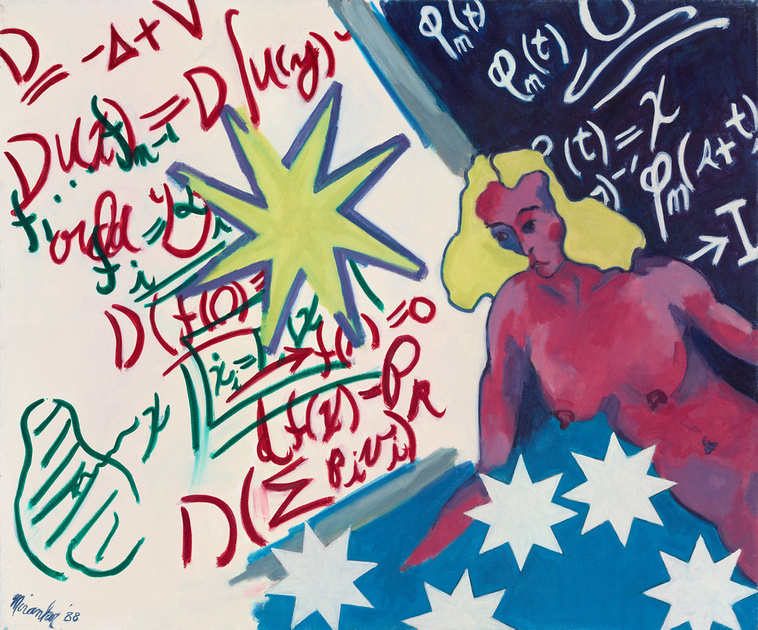 Blond Nude and Stars with Equations1988, 48 x 40
Blond Nude and Stars with Equations1988, 48 x 40
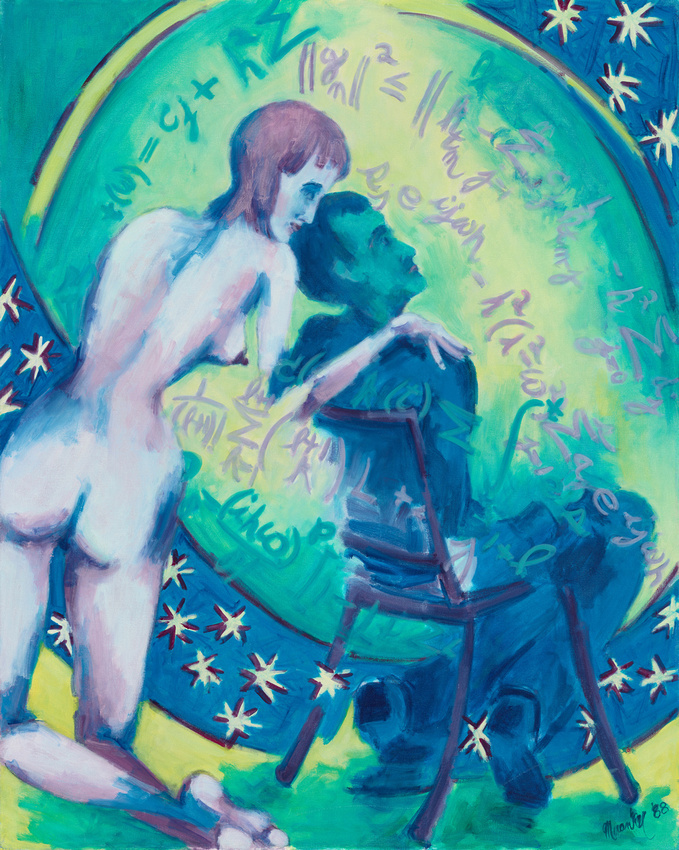 Muse, Man with his Equations1988, 50 x 60
Muse, Man with his Equations1988, 50 x 60
Finally, I leave you with the opening paragraph of Miranker and Winkler, "A Feynman Path Integral Formalism for General Evolution Equations". This is followed by the full paper.
Feynman's idea of realizing the propagator for the Schrödinger equation as an integral over all paths of a phase function, with phase proportional to the classical action, has served as a philosophical starting point for understanding and constructing modem field and particle theories. In contrast to classical mechanics, which has meaningful content for an arbitrary choice of Hamiltonian, the path integral of Feynman does not successfully generalize to even the simplest modifications of the Schrödinger equation. It is shown here how recourse to phase space allows the introduction of a path integral formalism which is valid for a broad class of Hamiltonians, including matrix valued ones such as the Dirac operator. Like the version of Feynman, the phase for the phase space path integral introduced here is the classical action, but now expressed in Hamiltonian form.
 Feynman Path IntegrationMiranker and Winkler, 1988
Feynman Path IntegrationMiranker and Winkler, 1988
Comments
The flowers are part of another recurring theme. See:
http://willmiranker.zenfolio.com/blog/2014/6/queen-of-hearts
Sadly, this does not mean that I know what they symbolize!
I only know they get used again and again. Therefore,
they have significance.
Andrew
In "Math Demons" my eyes are drawn to the flowers. They're angular and vibrant in contrast to the rest of the painting. Do you have any thoughts on what they could symbolize?
I enjoyed the post of Will's paper as well, really interesting.
Thanks!
